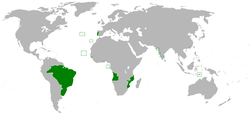United Kingdom of Portugal, Brazil and the Algarves Reino Unido de Portugal, Brasil e Algarves | |||||||||||||
|---|---|---|---|---|---|---|---|---|---|---|---|---|---|
| Anthem: Hymno Patriótico | |||||||||||||
 The United Kingdom of Portugal, Brazil and the Algarves with its colonies | |||||||||||||
| Capital | Rio de Janeiro Lisbon | ||||||||||||
| Common languages | Portuguese | ||||||||||||
| Religion | Roman Catholicism | ||||||||||||
| Government | Real union (before 1820) Federal monarchy (after 1820) | ||||||||||||
| Monarch | |||||||||||||
• 1815–1816 | Maria I | ||||||||||||
• 1816–1825 | John VI | ||||||||||||
| Regent | |||||||||||||
• 1815–1816 | Prince John | ||||||||||||
• 1821–1825 | Prince Pedro (Regent of the Kingdom of Brazil only) | ||||||||||||
| Legislature | Cortes Gerais (1820–1823) | ||||||||||||
| History | |||||||||||||
| 16 December | |||||||||||||
| 24 August 1820 | |||||||||||||
| 7 September 1822 | |||||||||||||
| 23 September 1822 | |||||||||||||
| 29 August 1825 | |||||||||||||
| Population | |||||||||||||
• 1820 | 4,000,000 (Brazil), 3,000,000 (Portugal) | ||||||||||||
| Currency | Real | ||||||||||||
| ISO 3166 code | PT | ||||||||||||
| |||||||||||||
| Motto: Alles Erdreich Ist Österreich Untertan (German)[1] ("All the world is subject to Austria") | |||||||||||||||||||||||
| Anthem: Heil dir im Siegerkranz[2] ("Hail to Thee in the Victor's Crown") Die Wacht am Rhein (unofficial)[3][4][5] ("The Watch on the Rhine") | |||||||||||||||||||||||
 The German colonial empire in 1914 | |||||||||||||||||||||||
| Capital and largest city | Berlin 52°31′7″N 13°22′34″E / 52.51861°N 13.37611°E | ||||||||||||||||||||||
| Official languages | German | ||||||||||||||||||||||
| Common languages | List
| ||||||||||||||||||||||
| Religion | 1880 census Majority: 62.63% United Protestant (Lutheran, Reformed) Minorities: 35.89% Roman Catholic 1.24% Jewish 0.17% other Christian 0.07% other | ||||||||||||||||||||||
| Demonym(s) | German | ||||||||||||||||||||||
| Government | Federal parliamentary absolute monarchy | ||||||||||||||||||||||
| Emperor | |||||||||||||||||||||||
• 1871–1888 | Wilhelm I | ||||||||||||||||||||||
• 1888 | Friedrich III | ||||||||||||||||||||||
• 1888–1918 | Wilhelm II | ||||||||||||||||||||||
| Chancellor | |||||||||||||||||||||||
• 1871–1890 | Otto von Bismarck | ||||||||||||||||||||||
• 1890–1894 | Leo von Caprivi | ||||||||||||||||||||||
• 1894–1900 | C. zu Hohenlohe-Schillingsfürst | ||||||||||||||||||||||
• 1900–1909 | Bernhard von Bülow | ||||||||||||||||||||||
• 1909–1917 | T. von Bethmann Hollweg | ||||||||||||||||||||||
• 1917 | Georg Michaelis | ||||||||||||||||||||||
• 1917–1918 | Georg von Hertling | ||||||||||||||||||||||
• 1918 | Max von Baden | ||||||||||||||||||||||
| Legislature | Bicameral | ||||||||||||||||||||||
• Upper house | Bundesrat | ||||||||||||||||||||||
• Lower house | Reichstag | ||||||||||||||||||||||
| Historical era | New Imperialism • World War I | ||||||||||||||||||||||
| 18 January 1871 | |||||||||||||||||||||||
| 16 April 1871 | |||||||||||||||||||||||
| 15 November 1884 | |||||||||||||||||||||||
| 28 July 1914 | |||||||||||||||||||||||
| 3 November 1918 | |||||||||||||||||||||||
| 9 November 1918 | |||||||||||||||||||||||
| 11 November 1918 | |||||||||||||||||||||||
| 11 August 1919 | |||||||||||||||||||||||
| Area | |||||||||||||||||||||||
• Total | 1,750,000 km2 (680,000 sq mi) | ||||||||||||||||||||||
| 1910[7] | 540,857.54 km2 (208,826.26 sq mi) | ||||||||||||||||||||||
| Population | |||||||||||||||||||||||
• Estimate | 70,000,000 | ||||||||||||||||||||||
• 1871[8] | 41,058,792 | ||||||||||||||||||||||
• 1900[8] | 56,367,178 | ||||||||||||||||||||||
• 1910[8] | 64,925,993 | ||||||||||||||||||||||
| Currency | Until 1873: (1873–1914) German Papiermark (1914–1918) | ||||||||||||||||||||||
| |||||||||||||||||||||||
Area and population not including colonial possessions | |||||||||||||||||||||||
| Lucinda Wiltorn-Bourke 1st Countess Bourke | Everett Valentine Wiltorn 4th Viscount Wiltorn | ||||||||||||||||||||||||
| Charles Wiltorn-Bourke | Esther Wiltorn-Bourke | Sibyl Wiltorn-Bourke | |||||||||||||||||||||||
| My brother Joe | Me! | My little sister | |||||||||||||||||||||||
- ^ Preble, George Henry, History of the Flag of the United States of America: With a Chronicle of the Symbols, Standards, Banners, and Flags of Ancient and Modern Nations, 2nd ed, p. 102; A. Williams and co, 1880
- ^ Fischer, Michael; Senkel, Christian (2010). Klaus Tanner (ed.). Reichsgründung 1871: Ereignis, Beschreibung, Inszenierung. Münster: Bachmann Verlag.
- ^ Hansen, Hans Jürgen (1978). Heil Dir im Siegerkranz: die Hymnen der Deutschen. Oldenburg, Hamburg: Stalling. ISBN 3-7979-1950-6.
- ^ von ADELHEID, K. L. A. I. B. E. R. ""Max Schneckenburger (1819–1849)–der Dichter der "Wacht am Rhein "". SCHRIFTEN DER BAAR. p. 165. Retrieved 9 September 2023.
- ^ Ochsmann, Almut. "100 Jahre deutsche Nationalhymne: Überlegungen zu Eine vaterländische Ouvertüre op. 140." Mitteilungen der Internationalen Max-Reger-Gesellschaft 3.42 (2022): 18–23.
- ^ Statement of Abdication of Wilhelm II
- ^ "German Empire: administrative subdivision and municipalities, 1900 to 1910" (in German). Archived from the original on 26 December 2018. Retrieved 25 April 2007.
- ^ a b c "Population statistics of the German Empire, 1871" (in German). Archived from the original on 5 April 2007. Retrieved 25 April 2007.








